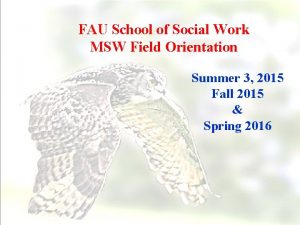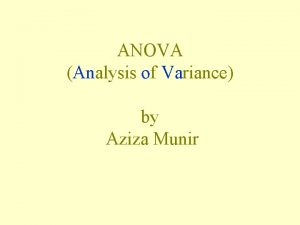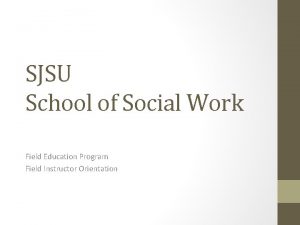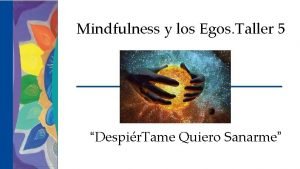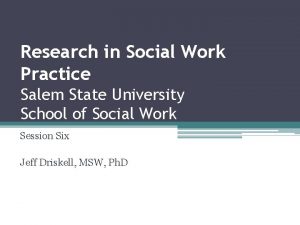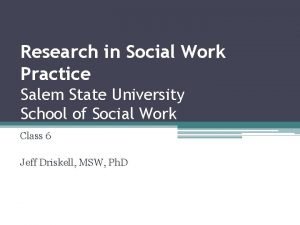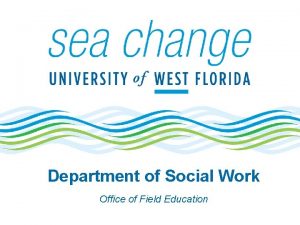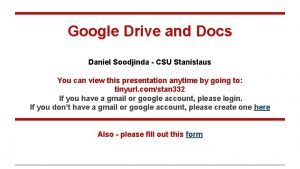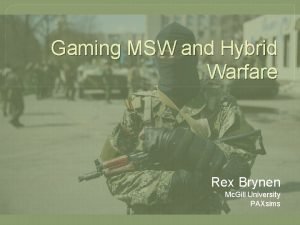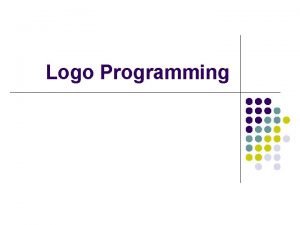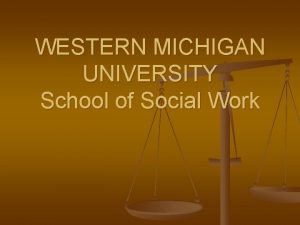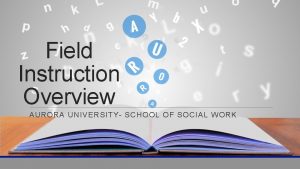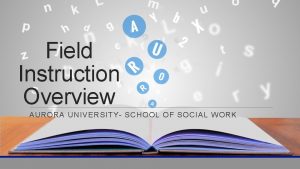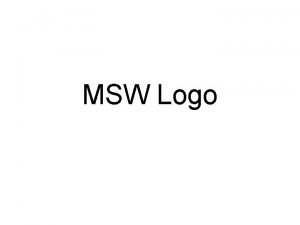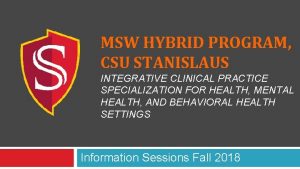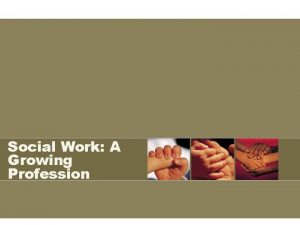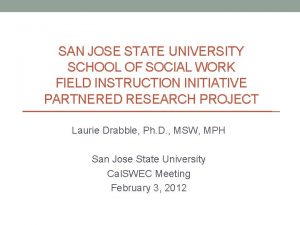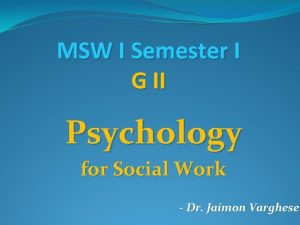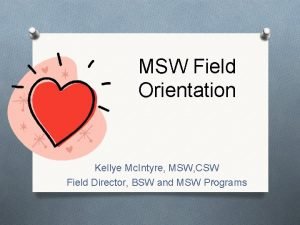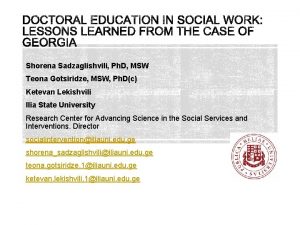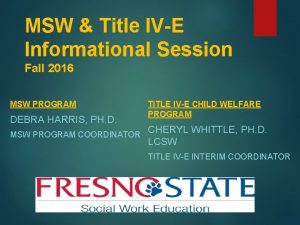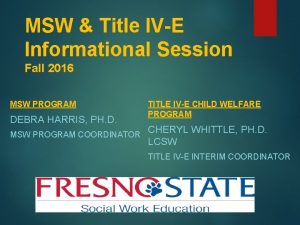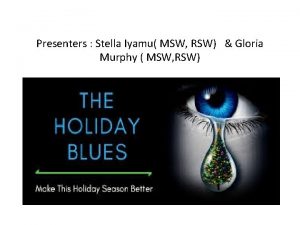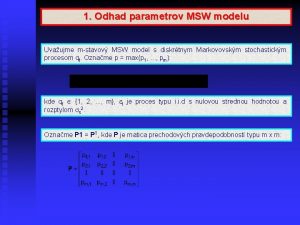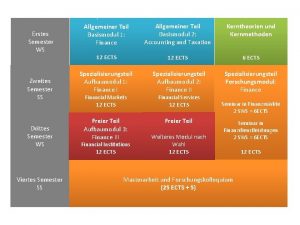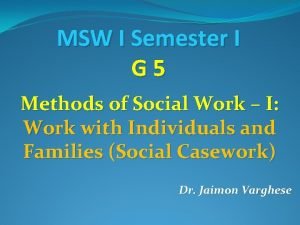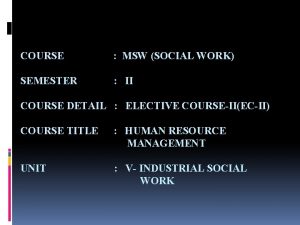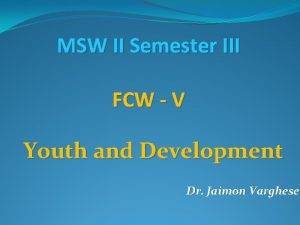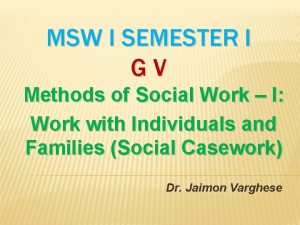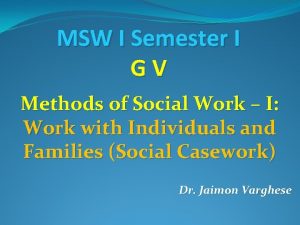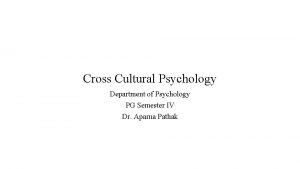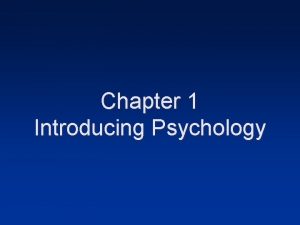MSW I Semester I G II Psychology for













































- Slides: 45

MSW I Semester I G II Psychology for Social Work - Dr. Jaimon Varghese

5. Problems of maladjustment in children, adults and Intervention 5. 1. Nature and types of problems 5. 2. Method and types of Interventions 02 -02 -2022 05: 17: 55 Psychology for Social Workers 2

5. 1. Nature and types of problems Definition of mental disorder (DSM 5, p. 20) • A mental disorder is a syndrome characterized by clinically significant disturbance in an individual’s cognition, emotion regulation, or behavior that reflects a dysfunction in the psychological, biological, or developmental processes underlying mental functioning. • Mental disorders are usually associated with significant distress or disability in social, occupational, or other important activities. 02 -02 -2022 05: 17: 55 Psychology for Social Workers 3

5. 1. Nature and types of problems • Socially deviant behavior (e. g. , political, religious, or sexual) and conflicts that are primarily between the individual and society are not mental disorders unless the deviance or conflict results from a dysfunction in the individual, as described above (DSM 5: 20) • Eleven indicators are recommended for diagnostic purpose: shared neural substrates, family traits, genetic risk factors, specific environmental risk factors, biomarkers, temperamental antecedents, abnormalities of emotional or cognitive processing, symptom similarity, course of illness, high comorbidity, and shared treatment response (DSM 5: 12) 02 -02 -2022 05: 17: 56 Psychology for Social Workers 4

5. 1. Nature and types of problems • It was demonstrated that clustering of disorders according to what has been termed internalizing and externalizing factors represents an empirically supported framework. • Within the internalizing group (representing disorders with prominent anxiety, depressive, and somatic symptoms) and the externalizing group (representing disorders with prominent impulsive, disruptive conduct, and substance use symptoms), including disorders exhibiting antisocial behaviours, conduct disturbances, addictions, and impulsecontrol disorders (DSM 5: 13) 02 -02 -2022 05: 17: 56 Psychology for Social Workers 5

5. 1. Nature and types of problems • To improve clinical utility, DSM-5 is organized on developmental and lifespan considerations. • It begins with diagnoses thought to reflect developmental processes that manifest early in life (e. g. , neurodevelopmental and schizophrenia spectrum and other psychotic disorders), • followed by diagnoses that more commonly manifest in adolescence and young adulthood (e. g. , bipolar, depressive, and anxiety disorders), and • ends with diagnoses relevant to adulthood and later life (e. g. , neurocognitive disorders) (DSM 5: 14) 02 -02 -2022 05: 17: 56 Psychology for Social Workers 6

5. 1. Nature and types of problems • It requires clinical training to recognize when the combination of predisposing, precipitating, perpetuating, and protective factors has resulted in a psychopathological condition in which physical signs and symptoms exceed normal ranges. • The ultimate goal of a clinical case formulation is to use the available contextual and diagnostic information in developing a comprehensive treatment plan that is informed by the individual's cultural and social context (DSM 5: 19) 02 -02 -2022 05: 17: 57 Psychology for Social Workers 7

5. 1. Nature and types of problems • The diagnosis of a mental disorder should have clinical utility: it should help clinicians to determine prognosis, treatment plans, and potential treatment outcomes for their patients. • Need for treatment is a complex clinical decision that takes into consideration symptom severity, symptom salience (e. g. , the presence of suicidal ideation), the patient's distress (mental pain) associated with the symptom(s), disability related to the patient's symptoms, risks and benefits of available treatments, and other factors (e. g. , psychiatric symptoms complicating other illness). 02 -02 -2022 05: 17: 58 Psychology for Social Workers 8

5. 1. Nature and types of problems • Clinicians may thus encounter individuals whose symptoms do not meet full criteria for a mental disorder but who demonstrate a clear need for treatment or care. • Approaches to validating diagnostic criteria for discrete categorical mental disorders have included the following types of evidence: antecedent validators (similar genetic markers, family traits, temperament, and environmental exposure), concurrent validators (similar neural substrates, biomarkers, emotional and cognitive processing, and symptom similarity), and predictive validators (similar clinical course and treatment response). (DSM 5: 20) 02 -02 -2022 05: 17: 58 Psychology for Social Workers 9

5. 1. Nature and types of problems International Statistical Classification of Diseases and Related Health Problems 10 th Revision (ICD- 10) • ICD 10 is a coding of diseases and signs, symptoms, abnormal findings, complaints, social circumstances and external causes of injury or diseases, as classified by the World Health Organization (WHO). • ICD 11 is underway. Presently it is an online platform and will be stable by 2019 • The document is popularly known as Blue Book. It has 22 chapters classifying all the known diseases in the world. • The chapter 5 classifies mental and behavioural disorders. 02 -02 -2022 05: 17: 59 Psychology for Social Workers 10

ICD 11 description of disorders 1. ICD Entity Title - Fully Specified Name 2. Classification Properties - disease, disorder, injury, etc. 3. Textual Definitions - short standard description 4. Terms - synonyms, other inclusion and exclusions 5. Body System/Structure Description - anatomy and physiology 6. Temporal Properties - acute, chronic or other 7. Severity of Subtypes Properties - mild, moderate, severe, or other scales 02 -02 -2022 05: 17: 59 Psychology for Social Workers 11

ICD 11 description of disorders 8. Manifestation Properties - signs, symptoms 9. Causal Properties - etiology: infectious, external cause, etc. 10. Functioning Properties - impact on daily life: activities and participation 11. Specific Condition Properties - relates to pregnancy etc. 12. Treatment Properties - specific treatment considerations: e. g. resistance 13. Diagnostic Criteria - operational definitions for assessment 02 -02 -2022 05: 18: 00 Psychology for Social Workers 12

ICD 10 classification Chapter V: Mental and behavioural disorders (F 00 -F 99) • F 00–F 09 Organic, including symptomatic, mental disorders • F 10–F 19 Mental and behavioural disorders due to psychoactive substance use • F 20–F 29 Schizophrenia, schizotypal and delusional disorders • F 30–F 39 Mood (affective) disorders • F 40–F 48 Neurotic, stress related and somatoform disorders 02 -02 -2022 05: 18: 00 Psychology for Social Workers 13

ICD 10 classification Chapter V: Mental and behavioural disorders (F 00 -F 99) • F 50–F 59 Behavioural syndromes associated with physiological disturbances and physical factors • F 60–F 69 Disorders of adult personality and behaviour • F 70–F 79 Mental retardation • F 80–F 89 Disorders of psychological development • F 90–F 98 Behavioural and emotional disorders with onset usually occurring in childhood and adolescence • F 99 Unspecified mental disorder 02 -02 -2022 05: 18: 00 Psychology for Social Workers 14

DSM 5 classification of disorders • The Diagnostic and Statistical Manual of Mental Disorders (DSM) is published by the American Psychiatric Association and provides a common language and standard criteria for the classification of mental disorders. • There have been five revisions since it was first published in 1952 (DSM I), gradually including more mental disorders, although some have been removed and are no longer considered to be mental disorders, most notably homosexuality (DSM II in 1968). 02 -02 -2022 05: 18: 00 Psychology for Social Workers 15

DSM 5 classification • The manual evolved from systems for collecting census and psychiatric hospital statistics, and from a manual developed by the US Army, and was dramatically revised in 1980 (DSM III). • DSM-III-R (Diagnostic Statistical Manuel III Revised in 1987), DSM-IV (published in 1994 including 297 disorders in 886 pages), DSM IVTR (Text Revision, 2000) • DSM V published in 2013 is in the current use. It has incorporated ICD 10 classification (coding) in its classification. 02 -02 -2022 05: 18: 00 Psychology for Social Workers 16

DSM 5 classification 1. Neuro developmental Disorders (DSM 5, p. 31) 2. Schizophrenia Spectrum and Other Psychotic Disorders (87) 3. Bipolar and Related Disorders (123) 4. Depressive Disorders (155) 5. Anxiety Disorders (189) 6. Obsessive-Compulsive and Related Disorders (235) 7. Trauma- and Stressor-Related Disorders (265) 02 -02 -2022 05: 18: 01 Psychology for Social Workers 17

DSM 5 classification 8. Dissociative Disorders (291) 9. Somatic Symptom and Related Disorders (309) 10. Feeding and Eating Disorders (329) 11. Elimination Disorders (355) 12. Sleep-Wake Disorders (361) 13. Sexual Dysfunctions (423) 14. Gender Dysphoria (451) 15. Disruptive, Impulse-Control, and Conduct Disorders (461) 02 -02 -2022 05: 18: 01 Psychology for Social Workers 18

DSM 5 classification 16. Substance-Related and Addictive Disorders (481) 17. Neurocognitive Disorders (591) 18. Personality Disorders (645) 19. Paraphilic Disorders (685) 20. Other Mental Disorders (707) 21. Medication-Induced Movement Disorders and Other Adverse Effects of Medication (709) 22. Other Conditions That May Be a Focus of Clinical Attention (715) 02 -02 -2022 05: 18: 02 Psychology for Social Workers 19

Behavioural problems in children Major behavioural problems in children (ICD 10 th Rev. Disorders from 70– 98) • F 70 -F 79: Mental retardation (mild, moderate, severe, profound) • F 80 Specific developmental disorders of speech and language • F 81 Specific developmental disorders of scholastic skills • F 82 Specific developmental disorder of motor function 02 -02 -2022 05: 18: 02 Psychology for Social Workers 20

Behavioural problems in children Major behavioural problems in children (ICD 10 th Rev. Disorders from 70– 98) • F 84 Pervasive developmental disorders (autism, Rett’s syndrome (only girls), Asperger’s syndrome mostly for boys) • F 90 Hyperkinetic disorders • F 91 Conduct disorders (unsocialised, defiance, etc. ) • F 92 Mixed disorders of conduct and emotions (depression) 02 -02 -2022 05: 18: 03 Psychology for Social Workers 21

Behavioural problems in children Major behavioural problems in children (ICD 10 th Rev. Disorders from 70– 98) • F 93 Emotional disorders with onset specific to childhood (separation anxiety, phobia, social anxiety, sibling rivalry) • F 94 Disorders of social functioning with onset specific to childhood and adolescence (mutism, reactive attachment – indifference and defiance to care givers, disinhibited attachment – indiscriminate clinging and friendliness) 02 -02 -2022 05: 18: 03 Psychology for Social Workers 22

Behavioural problems in children Major behavioural problems in children (ICD 10 th Rev. Disorders from 70– 98) • F 95 Tic disorders (chronic motor, vocal tic) • F 98 Other behavioural and emotional disorders with onset usually occurring in childhood and adolescence (enuresis – urination disorder, encopresis – bowl disorder, feeding disorder – resistance to eat, pica – eating non nutrient articles, stuttering - stammering, cluttering – quick speech, stereotyped movement) 02 -02 -2022 05: 18: 05 Psychology for Social Workers 23

5. 2. Method and types of Interventions What are the major approaches in psychotherapy? • Psychoanalysis (Sigmund Freud, Adler, Erikson): free association, dream analysis, idsuper ego balancing by ego, defense mechanism • Client centred or humanistic (Rogers, Maslow) • Transactional Analysis (Decontamination of client’s Adult ego state; De-confusing the Child ego state and developing an internal nurturing parent; integration of new decisions and experimenting with new ways of being 02 -02 -2022 05: 18: 05 Psychology for Social Workers 24

5. 2. Method and types of Interventions • Rational Emotive Behaviour Therapy (Albert Ellis) • Behaviour Therapies • Systematic Desensitization (Joseph Wolpe, 1958) Relaxation: (Jacobson, 1938) Anxiety hierarchies: Desensitization: • Aversive conditioning • Imaginal Flooding Therapies: • Vivo Therapies: • Modelling Techniques: 02 -02 -2022 05: 18: 06 Psychology for Social Workers 25

5. 2. Method and types of Interventions Group Psychotherapy (peer groups, Alcohol Anonymous) • A means of changing behaviour and emotional patterns, based on the premise that much of human behaviour and feeling involves the individual's adaptation and response to other people. • It is a process carried out in formally organized groups of three or more individuals who seek change, whether their problem is alcoholism, overeating, or poor social skills. • The composition of a group may be heterogeneous or homogeneous with reference to the age of the members or the type of problem. 02 -02 -2022 05: 18: 06 Psychology for Social Workers 26

5. 2. Method and types of Interventions • The therapist may be directive or nondirective, allowing the group to set their own agenda for discussion. • The group becomes a “sample” of the outside world, reproducing conditions of interpersonal relationships; its members jointly participate in observing personal motivation and styles of interaction. • They also participate in attempting new behaviours and dealing with the consequences of such behaviours, with the intended result that they will eventually be able to employ these behaviour patterns outside the group. 02 -02 -2022 05: 18: 07 Psychology for Social Workers 27

5. 2. Method and types of Interventions Other approaches & techniques of psychological counselling include: • occupational therapy, • art therapy, • exposure therapy, • play therapy, • psycho education, • yoga / meditation therapy, • biofeedback 02 -02 -2022 05: 18: 07 Psychology for Social Workers 28

5. 2. Method and types of Interventions Other approaches & techniques : • visualisations (mental imagery), • massage therapy, • technology medicines (electronic media), telemedicine (video conference), • telephone counselling, radio counselling, ecommunication medicines, • self help groups, • taking counselling from religious heads, • animal assisted therapies (loving pet animals), etc. (Medha Vasishit, 2008) 02 -02 -2022 05: 18: 08 Psychology for Social Workers 29

Psychological Counselling • Psychological Counselling is a learning oriented process carried in a simple one to one social environment, in which the counsellor seeks to assist the client by methods appropriate to the latter’s needs (Gustad) • Counselling is the process of aiding the individual to solve his problems through the medium of interview (Brodin) 02 -02 -2022 05: 18: 08 Psychology for Social Workers 30

Psychological Counselling counselling procedure • Fill up application and personal information forms • Identify the counselling need: educational, vocational or personal • Goal setting (mutually agreed): educational, vocational or personal • Scheduling the sessions (weekly / monthly) • Discuss with the counselee about the scope of counselling, various approaches, possible outcome and limitations 02 -02 -2022 05: 18: 08 Psychology for Social Workers 31

Psychological Counselling • Goal of counselling is to help individuals overcome many of their present and future problems • Major objective of all counselling is to help individual to become self sufficient, self dependent, self directed and to adjust themselves efficiently to the demands of a better and meaningful life • Individuals are provided with assistance to improve their personal, social, emotional and intellectual development 02 -02 -2022 05: 18: 09 Psychology for Social Workers 32

Psychological Counselling • Counselling services are developmental, preventive and therapeutic in nature • Counselling is an interactive process conjoining the counsellee who needs assistance and the counsellor who is trained to give this assistance (Perez) • Counselling is the process in which the counsellor assists the counsellee to make interpretations of facts relating to choices, plans or adjustments which he needs to make 02 -02 -2022 05: 18: 09 Psychology for Social Workers 33

Psychological Counselling • Counselling is a process which takes place in a one to one, face to face relationship between an individual beset by a problem with which he cannot cope alone and a professional worker whose training and experience have qualified him to help others to reach solutions to various types of personal difficulties • Counselling helps one to understand • What he is • What he desires / needs right now • What he wants to become in the future 02 -02 -2022 05: 18: 10 Psychology for Social Workers 34

Psychological Counselling Conditions essential for counselling • Person to person and face to face interaction • A person who is genuinely in need of help and he seeks it voluntarily • Warm, friendly and professional relationship (rapport) between counsellor and the counsellee • Unconditional positive regard: the counsellee is accepted as ‘he is’ and not ‘as he aught to be’ 02 -02 -2022 05: 18: 10 Psychology for Social Workers 35

Psychological Counselling: Types Directive counselling • Analysis • Synthesis • Diagnosis • Prognosis • Counselling • Follow up 02 -02 -2022 05: 18: 10 Psychology for Social Workers 36

Psychological Counselling: Types Non directive (client centred / humanistic) • Individual does not recognise any need for counselling; does not perceive any problem • Perceives the problem as external to him; no sense of personal responsibility • Freely expresses the feelings; clearly sees the problems, but does not get clear perspectives 02 -02 -2022 05: 18: 11 Psychology for Social Workers 37

Psychological Counselling: Types Non directive (contd. ) • Finds some self responsibility, but vacillate; a state of indecision • Accepts responsibility, but sees contradictions and incongruence • Inhibitions are gradually overcome; expresses feelings freely. Incongruence between experience and awareness is overcome • He becomes a fully functioning person 02 -02 -2022 05: 18: 11 Psychology for Social Workers 38

Psychological Counselling: Types Eclectic (integrative) approach • Diagnosis • Unearth underlying causes • Halt aggravation of problems • Rectify etiological factors 02 -02 -2022 05: 18: 12 Psychology for Social Workers 39

Psychological Counselling: Types Group counselling • Small in size • Homogeneous members • Counsellor as an understanding observer • Multiple counselling: one client and several counsellors 02 -02 -2022 05: 18: 12 Psychology for Social Workers 40

Psychological Counselling: types Case conferences: (team work of psychologists, teachers and social workers) • Diagnosis • Treatment • Placement • Follow up 02 -02 -2022 05: 18: 13 Psychology for Social Workers 41

Psychological Counselling the disadvantaged • Rosenthal effect (popular belief: stereotype) • Pygmalion effect (poor self image and self fulfilling prophesy) 02 -02 -2022 05: 18: 13 Psychology for Social Workers 42

Psychological Counselling Who can be a counsellor? • Appropriately qualified (MA / MSW) • Experienced (at least one year apprenticeship / field training) • Knowledgeable of • Psychological bases of counselling • Theories of personality and human behaviour • Various approaches in psychotherapies 02 -02 -2022 05: 18: 14 Psychology for Social Workers 43

Psychological Counselling What is the general procedure of counselling? • Conducting the counselling sessions based on an appropriate therapeutic approach • Recording each session • Goal attainment on mutual satisfaction • Termination of regular counselling sessions • Follow up counselling (monthly, quarterly, half yearly or annual) • Compile the data for research 02 -02 -2022 05: 18: 15 Psychology for Social Workers 44

Thank You 02 -02 -2022 05: 18: 15 Psychology for Social Workers 45
 Fau orientation
Fau orientation F=msb/msw
F=msb/msw Aka.msw
Aka.msw Sjsu social work
Sjsu social work Msw el callado
Msw el callado Montemarta
Montemarta Salem state social work
Salem state social work Salem state msw
Salem state msw Windlass healthcare
Windlass healthcare Uwf msw
Uwf msw Csu google drive
Csu google drive Csumb msw
Csumb msw Msw vtmis
Msw vtmis Msw games
Msw games Programski jezik logo
Programski jezik logo Pc logo turtle
Pc logo turtle Wmu msw application
Wmu msw application Aurora university moodle
Aurora university moodle University of texas arlington msw
University of texas arlington msw University of memphis school of social work
University of memphis school of social work Hazardous waste apes
Hazardous waste apes A flat fee pricing system for msw services
A flat fee pricing system for msw services Ucsf warn me
Ucsf warn me Aurora university msw
Aurora university msw Crtanje jednakokračnog trokuta
Crtanje jednakokračnog trokuta Hendrefoelan student village
Hendrefoelan student village Csu stanislaus msw
Csu stanislaus msw Msw scholarships 2019
Msw scholarships 2019 Msw
Msw San jose state school of social work
San jose state school of social work Edall button in msw logo
Edall button in msw logo För och nackdelar med firo
För och nackdelar med firo Tryck formel
Tryck formel Multiplikation med uppställning
Multiplikation med uppställning Kassaregister ideell förening
Kassaregister ideell förening Elektronik för barn
Elektronik för barn Borra hål för knoppar
Borra hål för knoppar Mat för unga idrottare
Mat för unga idrottare Smärtskolan kunskap för livet
Smärtskolan kunskap för livet Bris för vuxna
Bris för vuxna Teckenspråk minoritetsspråk argument
Teckenspråk minoritetsspråk argument Ledarskapsteorier
Ledarskapsteorier Trög för kemist
Trög för kemist Ellika andolf
Ellika andolf Datorkunskap för nybörjare
Datorkunskap för nybörjare Rita perspektiv
Rita perspektiv
